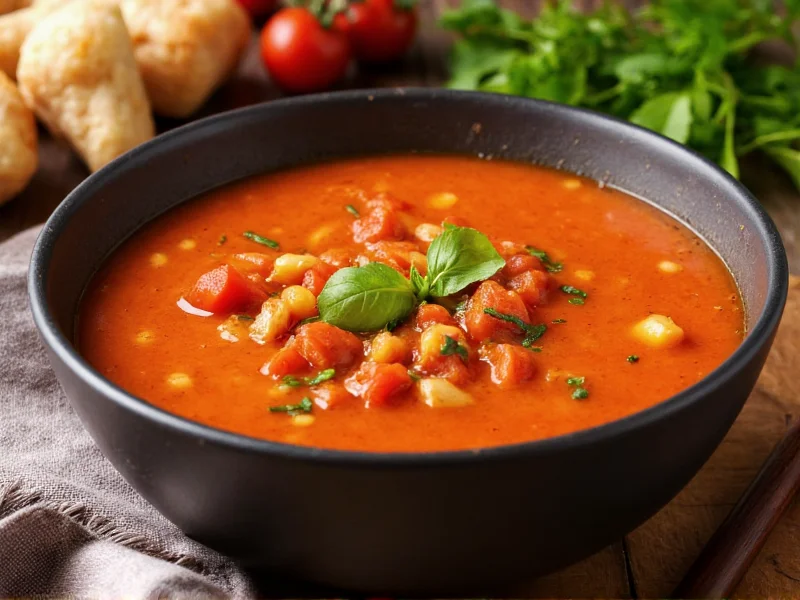Understanding the calorie content of hot and spicy soups is essential for anyone tracking their nutritional intake. Whether you're managing weight, following a specific diet, or simply making informed food choices, knowing what's in your bowl matters. This guide provides accurate calorie information while helping you make smarter decisions about enjoying these flavorful dishes.
Factors That Determine Hot and Spicy Soup Calories
Several key elements influence the calorie count in hot and spicy soups:
- Broth base - Clear vegetable or chicken broth typically contains 50-100 calories per cup, while coconut milk or cream-based broths can double that amount
- Protein sources - Chicken adds approximately 100-150 calories per 3-ounce serving, while tofu contributes about 70-90 calories
- Added oils - Many authentic recipes use chili oil or sesame oil, adding 120 calories per tablespoon
- Noodles or rice - These carbohydrate components can add 150-250 calories to your bowl
- Vegetable content - Generally low-calorie, but preparation methods affect the final count
Calorie Comparison of Popular Hot and Spicy Soups
| Soup Type | Standard Serving Size | Calorie Range | Key Calorie Contributors |
|---|---|---|---|
| Spicy Miso Soup | 1 cup (240ml) | 80-120 | Miso paste, tofu, chili paste |
| Hot and Sour Soup | 1.5 cups (350ml) | 150-250 | Egg, bamboo shoots, vinegar, chili |
| Spicy Ramen | Bowl (500-600g) | 500-800 | Noodles, pork belly, broth, egg |
| Tom Yum Soup | 1.5 cups (350ml) | 180-300 | Lemongrass, chili, shrimp, coconut milk |
| Sichuan Hot Pot Broth | 2 cups (475ml) | 300-500 | Chili oil, Sichuan peppercorns, meat |
Nutritional Benefits Beyond Calories
While tracking calories in hot and spicy soup is important, these dishes offer valuable nutritional components that shouldn't be overlooked. Capsaicin, the compound that gives chili peppers their heat, has been linked to several health benefits including temporary metabolism boost and pain relief. Many hot and spicy soups also contain:
- Antioxidants from chili peppers and spices
- Probiotics in fermented ingredients like miso
- Hydration from broth-based preparations
- Vitamins and minerals from vegetable components
Creating Lower-Calorie Hot and Spicy Soup Options
If you're watching your calorie intake but don't want to sacrifice flavor, consider these practical adjustments for hot and spicy soup calories:
- Opt for clear broth bases - Choose vegetable, chicken, or bone broth instead of coconut milk or cream-based options when possible
- Control oil portions - Measure chili oil rather than pouring freely (1 teaspoon contains about 40 calories)
- Increase vegetable density - Add mushrooms, bok choy, bean sprouts, and other low-calorie vegetables to increase volume without significant calorie addition
- Choose lean proteins - Select shrimp, tofu, or chicken breast over fattier meat options
- Modify noodle portions - Reduce noodle quantity by half or substitute with shirataki noodles for hot and sour soup calories reduction
Reading Restaurant Menus for Calorie Awareness
When dining out, understanding how to interpret menu descriptions can help you estimate hot and spicy soup calories more accurately. Terms like "creamy," "coconut milk," "loaded," or "extra oil" typically indicate higher calorie counts. Conversely, "light," "clear broth," or "vegetable-forward" suggest lower calorie options. Don't hesitate to ask about preparation methods when available.
Homemade vs. Restaurant Hot and Spicy Soup Calories
Preparing hot and spicy soup at home gives you complete control over ingredients and portions. A restaurant-sized bowl of spicy ramen often contains 700-1000 calories, while a homemade version with measured ingredients might come in at 400-500 calories. The difference primarily comes from:
- Restaurant portions being significantly larger
- Higher oil and seasoning content in commercial preparations
- Additional hidden ingredients like sugar or MSG
Tracking Your Hot and Spicy Soup Intake
For those using nutrition tracking apps, accurately logging hot and spicy soup calories requires attention to detail. Rather than selecting generic "soup" entries, search for specific varieties like "spicy miso soup" or "hot and sour soup" for more precise calorie counts. When making homemade versions, calculate based on your actual ingredients rather than guessing.











 浙公网安备
33010002000092号
浙公网安备
33010002000092号 浙B2-20120091-4
浙B2-20120091-4